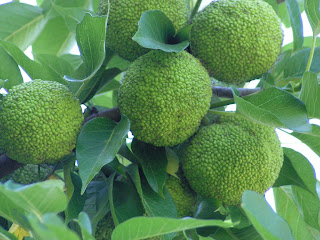Osage Orange fruits also known as hedge apples have shown repellent properties against mosquitoes and roaches in one study. It's the elemol, a sesquiterpene that's extracted from the osage orange that has everyone so excited. If you really want to read the abstract it is copied below. It's hard to find otherwise on the web.
We carry fresh hedge balls when they are in season - usually from July to September or so. You can find them here:
HedgeBalls

Natural insect repellents : Activity
against mosquitoes and cockroaches Auteur(s) / Author(s) SCHULTZ
Gretchen ; PETERSON Chris ; COATS Joel ; Résumé / Abstract Recent
research has focused on the repellent properties of extracts from the
catnip plant (Nepeta cataria) and the Osage orange (Maclura pomifera)
fruit. This chapter includes results on German cockroach (Blattella
germanica), and house fly (Musca domestica) contact irritancy to
catnip essential oil, and its major components, Z,E-nepetalactone and
E,Z-nepetalactone, compared with the commercial standard,
N,N-diethyl-m-toluamide (DEET). Both species showed high percentage
repellency values when exposed to filter paper treated with catnip
essential oil or the individual nepetalactone isomers. Of the two
nepetalactone isomers evaluated, German cockroaches were most
responsive to the E,Z isomer. House flies showed similar trends in
contact irritancy, responding to surfaces treated with the
predominant catnip isomer, Z,E-nepetalactone, more intensely than to
the catnip essential oil. Catnip and Osage orange essential oils, and
a sesquiterpene found in Osage orange, elemol, were evaluated for
repellency to the northern house mosquito (Culex pipiens) and are
presented here. Two mosquito bioassays were used to measure
percentage and contact repellecy. Mosquitoes responded initially with
high percentage repellency to surfaces treated with catnip essential
oil. From the residual repellency study, this trend in repellency by
the catnip oil significantly decreased over the 180-minute test
period. Elemol, and DEET initially had lower percentage repellency
values than catnip essential oil, but did not show the negative
relationship between percentage repellency and time, retaining
excellent repellency throughout the 3-hour bioassay. Solutions with
elemol and DEET exhibited greater significance in contact repellency
compared to catnip essential oil. These results show that catnip
essential oil is a potent mosquito repellent, but does not provide
the same residual effects as the commercial standard, DEET. Elemol, a
sesquiterpene extracted from the fruit of the Osage orange, shows
excellent promise as a mosquito repellent with comparable activity to
DEET in contact and residual repellency. Revue / Journal Title A.C.S.
symposium series ISSN 0097-6156 CODEN ACSMC8 Source / Source 2006,
vol. 927, pp. 168-181 [14 page(s) (article)] Langue / Language
Anglais Editeur / Publisher American Chemical Society, Washington,
DC, ETATS-UNIS (1974) (Revue) Localisation / Location INIST-CNRS,
Cote INIST : 17351, 35400015690515.0130 Title: Natural insect
repellents: activitity against mosquitoes and cockroaches Author:
Schultz, Gretchen; Peterson, Chris; Coats, Joel Date: 2006 Source:
In. A.M. Rimmando and S.O. Duke eds. Natural Products for Pest
Management. ACS Symposium Series #927. American Chemical Society,
Washington, DC. 169-181 Description: Recent research has focused on
the repellent properties of extracts from the catnip plant (Nepeta
cataria) and the Osage orange (Maclura pornifera) fruit. This chapter
includes results on German cockroach (Blattella germanica), and house
fly (Musca domestics) contact irritancy to catnip essential oil, and
its major components, Z,E-nepetalactone and 62- nepetalactone,
compared with the commercial standard, N,Ndiethyl- m-toluarnide
(DEET). Both species showed high percentage repellency valuec when
exposed to filter paper treated with camip essential oil or the
individual nepetalactone isomers. Of the two nepetalactone isomers
evaluated, German cockroaches were most responsive to the E,Z isomer.
House flies showed similar trends in contact irritancy, responding to
surfaces treated with the predominant catnip isomer,
Z,E-nepetalactone, more intensely than to the catnip essential oil.
Catnip and Osage orange essential oils, and a sesquiterpene found in
Osage orange, elemol, were evaluated for repellency to the northern
house mosquito (Culex pipiens) and are presented here. Two mosquito
bioassays were used to measure percentage and contact repellecy.
Mosquitoes responded initially with high percentage repellency to
surfaces treated with catnip essential oil. From the residual
repellency study, this trend in repellency by the catnip oil
significantly decreased over the 180-minute test period. Elemol, DEET
initially had lower percentage repellency values than catnip
essential oil, but did not show the negative relationship between
percentage repellency and time, retaining excellent repellency
throughout the 3-hour bioassay. Solutions with elemol and DEET
exhibited greater significance in contact repellency compared to
catnip essential oil. these results show that catnip essential oil is
a potent mosquito repellent, but does not provide the same residual
effects as the commercial standard, DEET. Elemol, a sesquiterpene
extracted from the fruit of the Osage orange, shows excellent promise
as a mosquito repellent with comparable activity to DEET in contact
and residual repellency.

